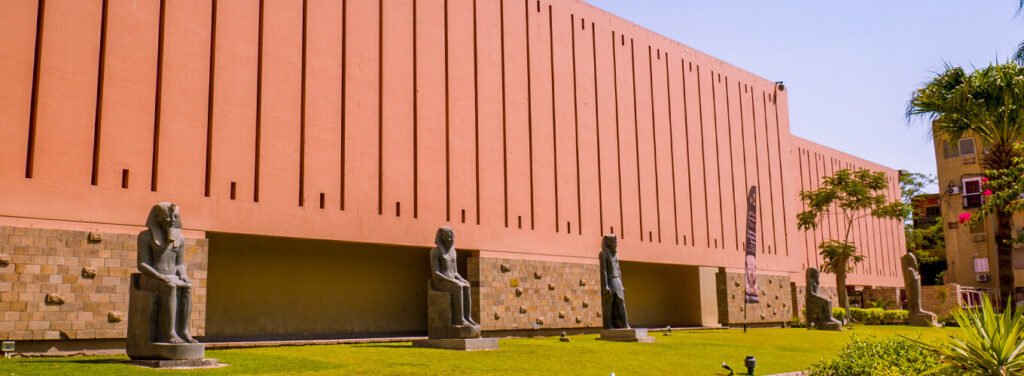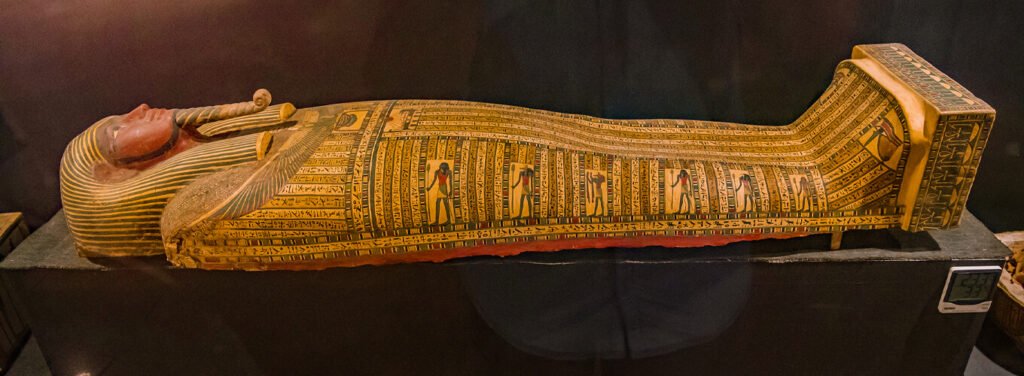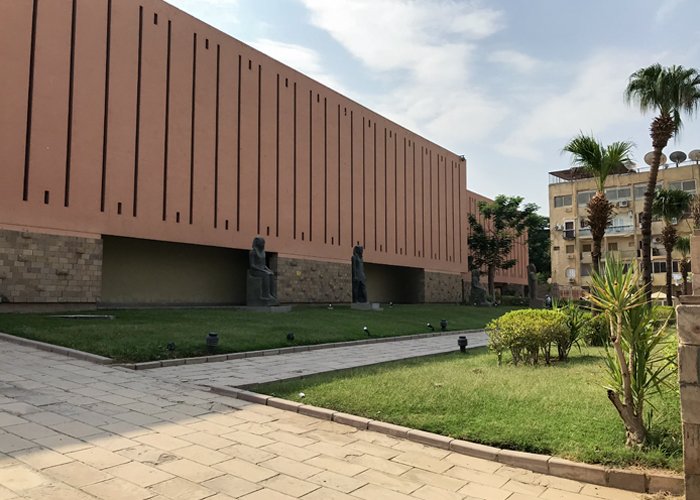Luxor Museum
Luxor Museum stands as one of Egypt’s most captivating cultural gems, nestled along the east bank of the Nile between the Karnak and Luxor Temples. This elegant museum, located in the heart of Luxor city, offers travelers a closer, more intimate look at ancient Egyptian history than any other site in the region. Designed with precision and care, the museum showcases a magnificent array of artifacts, from statues and jewelry to pottery and royal mummies, presenting them in an atmosphere that balances sophistication with storytelling.
For travelers exploring the historical city of Luxor, the Luxor Museum Egypt experience feels both serene and powerful. Unlike the overwhelming halls of Cairo’s Egyptian Museum, Luxor’s version is compact, beautifully curated, and emotionally stirring. Each exhibit is arranged to allow visitors to absorb the artistry and spiritual power of ancient Egypt at a comfortable pace. The lighting, the quiet ambiance, and the Nile views together create an unforgettable setting. Whether you’re a first-time visitor or a passionate Egyptologist, the museum in Luxor represents a journey back in time — a portal into the lives, beliefs, and legacy of the ancient pharaohs who once ruled the world’s greatest civilization.
History and Origins of Luxor Museum
The story of the Luxor Museum in Egypt begins in the late 1960s, when the Egyptian government sought to create a museum that could house artifacts found during local excavations in Thebes — modern-day Luxor. The goal was to give visitors an authentic sense of how the pharaonic world thrived in Upper Egypt. Construction began in 1962 under the supervision of Dr. Mahmoud El-Hakim, and the museum officially opened to the public in 1975.
What sets the Luxor Museum apart from others is its commitment to quality over quantity. While the Cairo Museum displays tens of thousands of objects, Luxor’s approach was different — only the finest and most historically important pieces were chosen. Over the years, the museum expanded to include a new annex opened in 2004, featuring treasures discovered in Luxor’s temples and tombs, including items from the famous tomb of Tutankhamun.
One of the museum’s most celebrated moments came in 1989, when two royal mummies were added to the exhibition — believed to be Ahmose I and Ramses I. Their presence transformed the museum into a must-see destination for scholars and travelers alike. Today, the Luxor Egyptian Museum continues to evolve, maintaining its role as a bridge between ancient artistry and modern preservation.
Location and Architectural Design

The Luxor Museum enjoys a prime location along the Corniche, directly overlooking the Nile River — about halfway between the Temple of Karnak and the Temple of Luxor. Its setting perfectly complements the city’s historical richness, offering both locals and tourists a peaceful retreat from the bustling streets. The site was chosen intentionally to connect the museum’s architecture with the spirit of ancient Thebes.
Designed by Egyptian architect Mahmoud El-Hakim, the museum’s architecture is a masterpiece of simplicity and balance. Built with clean lines, open spaces, and soft lighting, the museum Luxor captures the aesthetic harmony of modern design while echoing ancient Egyptian symmetry. Inside, the display strategy focuses on highlighting each artifact individually. Subtle illumination, neutral backgrounds, and open pathways ensure that the focus remains entirely on the exhibits themselves.
Visitors are often impressed by how the building interacts with natural light from the Nile, especially during sunset hours, when golden rays filter through the museum’s large glass walls. The architectural design was intentionally developed to provide an immersive experience — one that feels respectful, elegant, and deeply connected to the landscape around it. In essence, the museum isn’t just a place to view artifacts — it’s an architectural dialogue between ancient and modern Egypt.
Luxor Museum Exhibits and Collections
The Luxor Museum Egypt houses one of the finest collections of artifacts in the world, representing various dynasties from the Old Kingdom to the New Kingdom. Every object displayed has been carefully selected for its historical value, artistic merit, and state of preservation. Among the museum’s most iconic pieces are statues of Amenhotep III, Thutmose III, and Akhenaten, each standing tall with exquisite detail that captures the essence of royal power.
A key highlight is the Luxor Egyptian exhibit dedicated to the reign of Amenhotep III, showcasing masterpieces excavated from his mortuary temple at Kom el-Hetan. These include colossal statues and decorative pieces that reveal the luxury of the pharaoh’s court. Visitors also find breathtaking jewelry, carved stelae, and weapons discovered in tombs that narrate the evolution of art, religion, and craftsmanship in ancient Egypt.
Interactive displays, multimedia panels, and bilingual descriptions (Arabic and English) make the museum both educational and engaging. This thoughtful approach allows travelers to truly connect with Egypt’s ancient soul — making the museum in Luxor an unforgettable stop on any Nile adventure.
The Royal Mummies and the Luxor Body Museum Section
One of the museum’s most fascinating attractions is what many travelers refer to as the Luxor Body Museum — an area devoted to the display of royal mummies. Here, visitors encounter the preserved remains of two powerful rulers: Ahmose I, the founder of the 18th Dynasty who expelled the Hyksos from Egypt, and Ramses I, the founder of the 19th Dynasty. Their discovery in the royal cache at Deir el-Bahari and transfer to the Luxor Museum in Egypt represented a major event in Egyptology.
The presentation of the mummies is respectful and scientifically curated. Low lighting, temperature control, and informative panels explain the complex process of mummification, the religious beliefs surrounding death and rebirth, and the significance of preserving the body for eternity. This area gives visitors a powerful sense of connection with Egypt’s spiritual past.
Many travelers describe this as the emotional highlight of their visit — a rare chance to stand face-to-face with kings who ruled more than 3,000 years ago. It’s a moment that transcends time, transforming curiosity into reverence.
The Mummification Museum in Luxor: A Deep Dive
Just a short walk from the main Luxor Museum lies another remarkable institution — the Mummification Museum Luxor. While smaller, it offers detailed insight into the sacred art and science of preserving the body. Dedicated to Anubis, the god of embalming, this museum displays instruments, materials, and coffins used in the mummification process. Visitors can even see real mummified animals, including cats, crocodiles, and fish, each representing religious symbolism in ancient Egypt.
The Mummification Museum Luxor Egypt complements the main Luxor Museum perfectly. Together, they form a comprehensive journey into Egypt’s funerary traditions and beliefs about the afterlife. For travelers who wish to fully understand how Egyptians perceived immortality, both museums are must-visits.
The mummification museum in Luxor also emphasizes the importance of ritual purity and the role of priests during the embalming process. Interactive displays explain how resins, natron, and linen were used — offering an educational yet immersive experience that captivates all ages.
Luxor Museum vs. Mummification Museum – Key Differences

Although they are often mentioned together, the Luxor Museum and the Mummification Museum serve distinct purposes. The Luxor Museum focuses on art, sculpture, and royal legacy, while the Mummification Museum specializes in the science of preservation and religious rituals. The first celebrates life and civilization; the second explores death and eternity.
The Luxor Egypt Museum features monumental artifacts and royal statues that highlight the grandeur of Egypt’s golden ages, whereas the mummification museum Luxor provides a closer look at the physical and spiritual preparations for the afterlife. Visiting both gives travelers a well-rounded understanding of Egypt’s complex worldview — how the ancient Egyptians saw no separation between life, death, and rebirth.
Together, these two institutions represent two halves of the same story — one of artistic triumph and spiritual devotion. They are living testimonies to Egypt’s mastery of both the seen and unseen worlds.
Artifacts You Shouldn’t Miss at Luxor Museum Egypt
When visiting, there are several must-see treasures every traveler should admire. Among them:
- Statue of Thutmose III, made of black granite and known for its realistic details.
- Head of Amenhotep III, which captures the beauty and balance of Egyptian sculpture.
- Gold jewelry from the tomb of the princes, shimmering with ancient craftsmanship.
- War chariots and weapons from the New Kingdom period.
- Stelae and reliefs depicting daily life and royal ceremonies.
- Mummy of Ramses I, preserved perfectly for over 3,000 years.
Each artifact reflects Egypt’s evolving artistry and belief systems. The layout of the museum allows visitors to appreciate these pieces up close without overwhelming crowds, unlike larger museums elsewhere. Photography is permitted in certain areas, so many visitors love capturing Luxor Museum photos as keepsakes of their journey.
Modern Additions: Technology and Preservation Efforts
The Luxor Museum official website highlights the ongoing preservation efforts that ensure the safety of these priceless artifacts. The museum uses climate-controlled rooms, non-invasive cleaning techniques, and digital documentation systems to protect its treasures. Recently, augmented reality and 3D scanning technologies have been introduced to allow visitors to visualize how artifacts once appeared in their original temples and tombs.
Egypt’s Ministry of Tourism and Antiquities continues to support these advancements, recognizing the museum’s importance as a global heritage site. The blend of tradition and innovation makes Luxor Museum a pioneer in museum management across the Middle East and North Africa.
Luxor Museum Photos and Visitor Experience
Visitors often describe the Luxor Museum experience as peaceful and contemplative. The exhibits are arranged spaciously, allowing travelers to take their time without feeling rushed. The lighting highlights every detail, while soft music adds to the atmosphere. The Nile view from the entrance terrace is breathtaking — especially during sunset.
The museum’s photo policy allows photography in certain areas, and many visitors capture stunning images of statues framed against the Nile. Online, you can browse authentic Luxor Museum photos to preview what awaits you. Still, nothing compares to seeing it in person — where history and serenity merge.
Tickets, Opening Hours, and the Official Luxor Museum Website
- Location: Luxor Corniche, near the Nile promenade
- Opening Hours: Daily from 9:00 AM to 9:00 PM (subject to seasonal change)
- Ticket Prices: Around 160 EGP for adults, 80 EGP for students (updated regularly)
- Official Website: Luxor Museum Official Website
It’s recommended to visit in the late afternoon to enjoy the golden light that fills the museum. Guided tours are available, often combined with visits to Karnak and Luxor Temples. You can easily add this stop to your Luxor Egypt tours for a richer cultural experience.
Nearby Attractions: What to See Around the Museum in Luxor
After exploring the museum in Luxor, travelers can enjoy nearby wonders such as:
- Luxor Temple, just minutes away by foot.
- Karnak Temple Complex, a monumental site dedicated to Amun-Ra.
- The Valley of the Kings across the Nile, where royal tombs await.
- The Colossi of Memnon, massive statues greeting visitors on the west bank.
- The Mummification Museum, perfect for an additional hour of exploration.
- Local bazaars and cafes, where you can shop for souvenirs or relax by the Nile.
These attractions make Luxor a city where history comes alive at every corner.
Luxor Museum Las Vegas and Titanic Museum Luxor: Clearing Confusion
Some travelers mistakenly search for the Luxor Museum Las Vegas or Titanic Museum Luxor, assuming they are related to Egypt. In reality, these are entirely different attractions. The Luxor Museum Las Vegas refers to exhibits within the Luxor Hotel & Casino — themed around ancient Egypt but not authentic. Similarly, the Titanic Museum Luxor is part of a temporary exhibit hosted in Las Vegas, not in Egypt.
By contrast, the Luxor Museum in Egypt holds real pharaonic artifacts, genuine mummies, and centuries of history. Understanding this distinction ensures travelers plan their trips accurately and experience the true magic of Egypt’s heritage.
Conclusion – Why Luxor Museum Is a Must-Visit in Egypt
The Luxor Museum is not just a building filled with relics — it is a living bridge between Egypt’s glorious past and its vibrant present. Every statue, mummy, and artifact tells a story of resilience, art, and faith. For travelers seeking a deep, authentic experience, this museum is one of the most rewarding stops in all of Egypt.
From the elegant galleries to the breathtaking views of the Nile, every moment spent inside the Luxor Museum Egypt reminds you why this land has fascinated the world for millennia. Whether you come as a tourist, historian, or dreamer, Luxor welcomes you with open arms — offering a timeless journey through the cradle of civilization.




Comments are closed